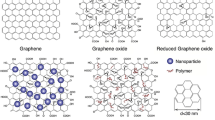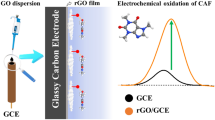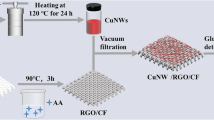Abstract
Carboxylic acid-functionalized multi-walled carbon nanotubes (COOH-MWCNT) were modified via ultrasonication with β-cyclodextrin (β-CD) to obtain a COOH-MWCNT:β-CD nanocomposite material for the purpose of developing an enzyme-free electrochemical sensor for uric acid—a clinically relevant molecule implemented in pregnancy-induced hypertension diagnosis. The nanocomposite material is deposited onto glassy carbon electrodes and subsequently capped with layers of Nafion and Hydrothane polyurethane. The surface morphology and electronic structure of the nanocomposite material were characterized using UV–Vis, TEM, and FTIR. The performance of the electrochemical sensor was measured through direct injection of UA during amperometry. With the high surface area of the COOH-MWCNT in concert with the selectivity provided by β-CD, the composite system outperforms similar COOH-MWCNT systems, displaying enhanced UA sensitivity versus films with only COOH-MWCNT. With the improved sensitivity (4.28 ± 0.11 µA mM−1) and fast response time (4.0 ± 0.5 s), the sensors offer wide detection of UA across clinically relevant ranges (100–700 μM) as well as demonstrated selectivity against various interferents.






Similar content being viewed by others
References
Erden PE, Kılıç E (2013) A review of enzymatic uric acid biosensors based on amperometric detection. Talanta 107:312–323
Li Y, Zhai X, Wang H, Liu X, Guo L, Ji X, Wang L, Qiu H, Liu X (2015) Non-enzymatic sensing of uric acid using a carbon nanotube ionic-liquid paste electrode modified with poly (β-cyclodextrin). Microchim Acta 182:1877–1884
Wu S, Wang T, Gao Z, Xu H, Zhou B, Wang C (2008) Selective detection of uric acid in the presence of ascorbic acid at physiological pH by using a β-cyclodextrin modified copolymer of sulfanilic acid and N-acetylaniline. Biosens Bioelectron 23:1776–1780
Chen X, Wu G, Cai Z, Oyama M, Chen X (2014) Advances in enzyme-free electrochemical sensors for hydrogen peroxide, glucose, and uric acid. Microchim Acta 181:689–705
Chauhan N, Pundir CS (2011) An amperometric uric acid biosensor based on multiwalled carbon nanotube-gold nanoparticle composite. Anal Biochem 413:97–103
Retna Raj C, Ohsaka T (2003) Voltammetric detection of uric acid in the presence of ascorbic acid at a gold electrode modified with a self-assembled monolayer of heteroaromatic thiol. J Electroanal Chem 540:69–77
Lakshmi D, Whitcombe MJ, Davis F, Sharma PS, Prasad BB (2011) Electrochemical detection of uric acid in mixed and clinical samples: a review. Electroanalysis 23:305–320
Moraes ML, Rodrigues Filho UP, Oliveira ON, Ferreira M (2007) Immobilization of uricase in layer-by-layer films used in amperometric biosensors for uric acid. J Solid State Electrochem 11:1489–1495
Wang Z, Wang Y, Luo G (2002) A selective voltammetric method for uric acid detection at β-cyclodextrin modified electrode incorporating carbon nanotubes. Analyst 127:1353–1358
Erden PE, Kaçar C, Öztürk F, Kılıç E (2015) Amperometric uric acid biosensor based on poly(vinylferrocene)-gelatin-carboxylated multiwalled carbon nanotube modified glassy carbon electrode. Talanta 134:488–495
Li Y, Ran G, Yi WJ, Luo HQ, Li NB (2012) A glassy carbon electrode modified with graphene and poly(acridine red) for sensing uric acid. Microchim Acta 178:115–121
Stafford RS (1990) Cesarean section use and source of payment: an analysis of California hospital discharge abstracts. Am J Public Health 80:313–315
Roberts JM, Bodnar LM, Lain KY, Hubel CA, Markovic N, Ness RB, Powers RW (2005) Uric acid is as important as proteinuria in identifying fetal risk in women with gestational hypertension. Hypertension 46:1263–1269
Conway GE, Lambertson RH, Schwarzmann MA, Pannell MJ, Kerins HW, Rubenstein KJ, Dattelbaum JD, Leopold MC (2016) Layer-by-layer design and optimization of xerogel-based amperometric first generation biosensors for uric acid. J Electroanal Chem 775:135–145
Poulos NG, Hall JR, Leopold MC (2015) Functional layer-by-layer design of xerogel-based first-generation amperometric glucose biosensors. Langmuir 31:1547–1555
DiPasquale LT, Poulos NG, Hall JR, Minocha A, Bui TA, Leopold MC (2015) Structure-function relationships affecting the sensing mechanism of monolayer-protected cluster doped xerogel amperometric glucose biosensors. J Colloid Interface Sci 450:202–212
Wang J (2005) Carbon-nanotube based electrochemical biosensors: a review. Electroanalysis 17:7–14
Alarcón-Ángeles G, Guix M, Silva WC, Ramírez-Silva MT, Palomar-Pardavé M, Romero-Romo M, Merkoçi A (2010) Enzyme entrapment by β-cyclodextrin electropolymerization onto a carbon nanotubes-modified screen-printed electrode. Biosens Bioelectron 26:1768–1773
Wang Z, Dong X, Li J (2008) An inlaying ultra-thin carbon paste electrode modified with functional single-wall carbon nanotubes for simultaneous determination of three purine derivatives. Sens Actuators B Chem 131:411–416
Bello A, Giannetto M, Mori G, Seeber R, Terzi F, Zanardi C (2007) Optimization of the DPV potential waveform for determination of ascorbic acid on PEDOT-modified electrodes. Sens Actuators B Chem 121:430–435
Du J, Yue R, Yao Z, Jiang F, Du Y, Yang P, Wang C (2013) Nonenzymatic uric acid electrochemical sensor based on graphene-modified carbon fiber electrode. Colloids Surf A Physicochem Eng Asp 419:94–99
Wayu MB, King JE, Johnson JA, Chusuei CC (2015) A zinc oxide carbon nanotube based sensor for in situ monitoring of hydrogen peroxide in swimming pools. Electroanalysis 27:2552–2558
Wang J, Musameh M, Lin Y (2003) Solubilization of carbon nanotubes by Nafion toward the preparation of amperometric biosensors. J ACS 125:2408–2409
Shi J, Claussen JC, McLamore ES, ul Haque A, Jaroch D, Diggs AR, Calvo-Marzal P, Rickus JL, Porterfield DM (2011) A comparative study of enzyme immobilization strategies for multi-walled carbon nanotube glucose biosensors. Nanotechnology 22:355502
Gooding JJ (2005) Nanostructuring electrodes with carbon nanotubes: a review on electrochemistry and applications for sensing. Electrochim Acta 50:3049–3060
Yang H, Zhu Y, Chen D, Li C, Chen S, Ge Z (2010) Electrochemical biosensing platforms using poly-cyclodextrin and carbon nanotube composite. Biosens Bioelectron 26:295–298
Li J, Feng H, Feng Y, Liu J, Liu Y, Jiang J, Qian D (2014) A glassy carbon electrode modified with β-cyclodextin, multiwalled carbon nanotubes and graphene oxide for sensitive determination of 1,3-dinitrobenzene. Microchim Acta 181:1369–1377
Gao Y-S, Wu L-P, Zhang K-X, Xu J-K, Lu L-M, Zhu X-F, Wu Y (2015) Electroanalytical method for determination of shikonin based on the enhancement effect of cyclodextrin functionalized carbon nanotubes. Chin Chem Lett 26:613–618
He Y, Xu Z, Yang Q, Wu F, Liang L (2015) Supramolecular modification of multi-walled carbon nanotubes with β-cyclodextrin for better dispersibility. J Nanopart Res 17:1–10
Xing Y, Li L, Chusuei CC, Hull RV (2005) Sonochemical oxidation of multiwalled carbon nanotubes. Langmuir 21:4185–4190
Tian L, Zhang B, Sun D, Chen R, Wang B, Li T (2014) A thin poly(acridine orange) film containing reduced graphene oxide for voltammetric simultaneous sensing of ascorbic acid and uric acid. Microchim Acta 181:589–595
Rafati AA, Afraz A, Hajian A, Assari P (2014) Simultaneous determination of ascorbic acid, dopamine, and uric acid using a carbon paste electrode modified with multiwalled carbon nanotubes, ionic liquid, and palladium nanoparticles. Microchim Acta 181:1999–2008
Szejtli J (1998) Introduction and general overview of cyclodextrin chemistry. Chem Rev 98:1743–1754
Soylemez S, Hacioglu SO, Kesik M, Unay H, Cirpan A, Toppare L (2014) A novel and effective surface design: conducting polymer/β-cyclodextrin host-guest system for cholesterol biosensor. Acs Appl Mater Interfaces 6:18290–18300
Zheng L, Wu S, Lin X, Nie L, Rui L (2001) Selective determination of uric acid by using a β-cyclodextrin modified electrode. Electroanalysis 13:1351–1354
Wayu MB, DiPasquale LT, Schwarzmann MA, Gillespie SD, Leopold MC (2016) Electropolymerization of β-cyclodextrin onto multi-walled carbon nanotube composite films for enhanced selective detection of uric acid. J Electroanal Chem 783:192–200
Fang B, Zhang C, Zhang W, Wang G (2009) A novel hydrazine electrochemical sensor based on a carbon nanotube-wired ZnO nanoflower-modified electrode. Electrochim Acta 55:178–182
Wayu MB, Spidle RT, Devkota T, Deb AK, Delong RK, Ghosh KC, Wanekaya AK, Chusuei CC (2013) Morphology of hydrothermally synthesized ZnO nanoparticles tethered to carbon nanotubes affects electrocatalytic activity for H2O2 detection. Electrochim Acta 97:99–104
Koh A, Lu Y, Schoenfisch MH (2013) Fabrication of nitric oxide-releasing porous polyurethane membranes-coated needle-type implantable glucose biosensors. Anal Chem 85:10488–10494
Freeman MH, Hall JR, Leopold MC (2013) Monolayer-protected nanoparticle doped xerogels as functional components of amperometric glucose biosensors. Anal Chem 85:4057–4065
Wayu MB, Pannell MJ, Leopold MC (2016) Layered xerogel films incorporating monolayer-protected cluster networks on platinum-black-modified electrodes for enhanced sensitivity in first-generation uric acid biosensing. ChemElectroChem 3:1245–1252
Kim C, Seo K, Kim B, Park N, Choi YS, Park KA, Lee YH (2003) Tip-functionalized carbon nanotubes under electric fields. Phys Rev B 68:115403
Fei T, Jiang K, Jiang F, Mu R, Zhang T (2014) Humidity switching properties of sensors based on multiwalled carbon nanotubes/polyvinyl alcohol composite films. J Appl Polym Sci 131:39726
Cao X, Luo L, Ding Y, Yu D, Gao Y (2009) Simultaneous determination of dopamine and uric acid on Nafion/sodium dodecylbenzenesulfonate composite film modified glassy carbon electrode. J Appl Electrochem 39:1603–1608
Chen K, Conway GE, Hamilton GA, Trawick ML, Leopold MC (2016) Electropolymerized layers as selective membranes in first generation uric acid biosensors. J Appl Electrochem 46:603–615
Koh A, Riccio DA, Sun B, Carpenter AW, Nichols SP, Schoenfisch MH (2011) Fabrication of nitric oxide-releasing polyurethane glucose sensor membranes. Biosens Bioelectron 28:17–24
Acknowledgements
This research was generously supported by funding from the National Science Foundation (CHE–1401593), Commonwealth Health Research Board, the College of Arts and Sciences (MAS), and the Department of Chemistry’s Puryear–Topham–Pierce Endowment (SDG). We would like to specifically thank Microscopy Director Christine A. Lacy (TEM and SEM) for her important contributions to this work. We gratefully acknowledge the following people for making research possible at the University of Richmond: Drs. T. Leopold, R. Kanters, D. Kellogg, R. Miller, and R. Coppage, as well as Russ Collins, Phil Joseph, Mandy Mallory, and Lamont Cheatham.
Author information
Authors and Affiliations
Corresponding author
Additional information
Margaret A. Schwarzmann and Samuel D. Gillespie have contributed equally to this work.
Electronic supplementary material
Below is the link to the electronic supplementary material.
Rights and permissions
About this article
Cite this article
Wayu, M.B., Schwarzmann, M.A., Gillespie, S.D. et al. Enzyme-free uric acid electrochemical sensors using β-cyclodextrin-modified carboxylic acid-functionalized carbon nanotubes. J Mater Sci 52, 6050–6062 (2017). https://doi.org/10.1007/s10853-017-0844-9
Received:
Accepted:
Published:
Issue Date:
DOI: https://doi.org/10.1007/s10853-017-0844-9




